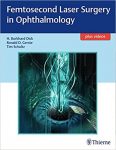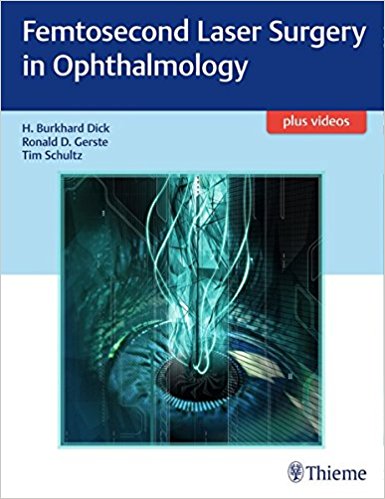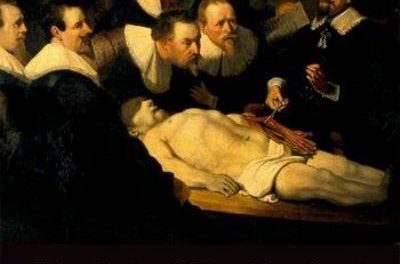 Editors: H. Burkhard Dick, Ronald D. Gerste, and Tim Schultz
Editors: H. Burkhard Dick, Ronald D. Gerste, and Tim Schultz
Publisher: Thieme – 206 pages
Book Review by: Nano Khilnani
Laser surgery is a type of surgery that uses a laser instead of a scalpel to cut tissue. Laser surgery is commonly used on the eye. Techniques used include LASIK (laser-assisted in situ keratomileusis) which is a type of refractive surgery for the correction of myopia (near-sightedness), hypercopia (farsightedness), or astigmatism (a refractive error in which the eye does not focus evenly on the retina (an inner coat of the eye which is a light-sensitive layer of tissue).
Other types of LASIK surgery are the photorefractive keratectomy, a procedure which permanently reshapes the cornea using an excimer laser to remove a small amount of human tissue, and the laser thermal keratoplasty, in which a ring of concentric burns is made on the cornea, which cause its surface to steepen, allowing better near vision.
Lasers are also used to treat non-refractive conditions, such as: photorefractive keratectomy (PTK) in which opacities and surface irregularities are removed from the cornea; and laser coagulation, in which a laser is used to cauterize blood vessels in the eye, to treat various conditions. Lasers can also be used to repair tears in the retina.
Some of the materials used in laser surgery include: argon, carbon dioxide, and potassium titanyl phosphate, which is a nonlinear optical material.
This book is on various types of laser surgery on the eye. Fifty-three specialists in laser surgery from around the United States and eight other countries – Australia, Austria, Germany, Greece, India, Spain, Switzerland, and Turkey – authored the 29 chapters of this book.
We name the chapters below to provide you an overview of what is covered in this book:
- Basics of Femtosecond Technology
- The Advent of the Femtosecond Laser in Medicine and Ophthalmology
- Femtosecond Laser-Assisted in Situ Keratomileusis (LASIK)
- All-in-one Femotosecond Refractive Laser Surgery
- Pearls in Femtosecond Laser-Assisted in Situ Keratomileusis (LASIK) Surgery
- Femtosecond Laser-Assisted in Situ Keratomileusis: Clinical Outcomes
- Femtosecond Laser-Assisted in Situ Keratomileusis: Complications and Management
- The Future of Laser-Assisted in Situ Keratomileusis: Femtosecond Laser versus Other Technologies
- Femtosecond Laser-Assisted Keratoplasty: Lamellar Anterior and Posterior
- Femtosecond Laser-Assisted Keratoplasty: Penetrating with Different Cut Profiles
- Correction of Astigmatism with a Femtosecond Laser
- Why Femtosecond Laser for Intracorneal Rings?
- New Innovative Applications of Femtosecond Laser Technology
- Laser’s Place in CXL: Excimer Laser and Refractive Surgery Combined with Corneal Cross-Linking, Femto-LASIK Combined with CXL
- The Femtosecond Laser in the Surgical Treatment of Presbyopia in the Cornea: Options and Limitations
- The Femtosecond Laser in the Surgical Treatment of Presbyopia in the Lens: Options and Limitations
- The Basics of Femtosecond Laser Cataract Surgery
- Femtosecond Laser Cataract Surgery: Setting and Infrastructure
- Crucial Steps I: Capsulotomy
- Crucial Steps II: Lens Fragmentation
- Crucial Steps III: Corneal Incision, Main and Side
- Posterior Capsulotomy, Bag-in-the-Lens and Evolving Techniques
- Pediatric Cataract Surgery with the Femtosecond Laser
- Femtosecond Laser-Assisted Cataract Surgery in Ocular Comorbidities
- The Rise of the Femto-Intraocular Lens
- Incorporating the Femtosecond Laser in Daily Practice
- The Femtosecond Laser and the Posterior Segment
- Pitfalls: Femtosecond Laser-Induced Complications
- The Femtosecond Laser: Future Directions
Video Contents: Seven videos pertaining to procedures covered in this book are available for viewing. Go to the first page of this book to get the access code, then visit www.MediaCenter.Thieme,com. When prompted during the registration, enter that access code.
The editors write in the Preface: “The femtosecond laser has emerged as a true game changer, first in corneal refractive where it was introduced for flap creation during LASIK and then from 2008 onward, in cataract surgery. In the industrialized world, cataract surgery is the most frequently performed invasive procedure, far ahead of the implantation of artificial hips and knees as well as of the removal of inflamed appendices and gall bladders. Only the number of extracted teeth might in some countries exceed the number of implanted ocular lens. It is common knowledge these days that cataract surgery is always a refractive surgery.”
“Femtosecond laser promises unsurpassed precision, particularly when creating capsulotomies; it seems to be safe and sometimes maybe safer (as studies in endothelial cell loss seem to indicate) than conventional phacoemulsification – and, speaking of phaco, it might make ultrasound application superfluous in many cases. What is truly fascinating about femtosecond laser-assisted cataract surgery (LCS)? We have a genuine all-comers approach, we have a technology that benefits virtually everybody due to its high precision, safety, and excellent results in the hands of an experienced surgeon.”
Among the key features of this volume are the following:
- Clinical pearls, outcomes, and complications management in femtosecond laser-assisted in situ keratomilieusis surgery
- Discussion of crucial steps including capsulotomy, lens fragmentation, and corneal incisions
- The use of femtosecond Laser for prebyopia, pediatric cataract surgery and ocular comorbidities
- Extensive videos in ThiemeMediaCenter.com that further elucidate techniques
- More than 300 high-quality illustrations and photos that ad a rich visual dimension
This is an excellent, pioneering, and extensive text on the introduction, spread, and work-in-progress of femtosecond laser technology and surgery in ophthalmology.
Editors:
Burkhard Dick, MD, PhD is Director of the University Eye Clinic and Chair of Ophthalmology at the University of Bochum in Bochum, Germany.
Ronald D. Gerste, MD, PhD is an Ophthalmologist, Historian, and Science Writer in North Potomac, Maryland.
Tim Schultz, MD, FEBO is an Ophthalmologist at University Hospital Bochum in Bochum, Germany.







